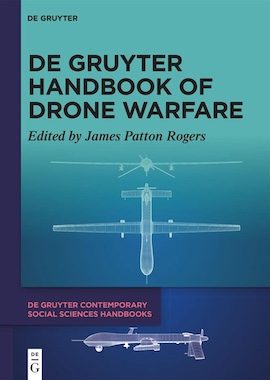SWJ Book Review − De Gruyter Handbook of Drone Warfare
Robert J. Bunker

James Patton Rogers, Ed., De Gruyter Handbook of Drone Warfare. Boston: De Gruyter, 2024 [ISBN: 978-3110741926, Hardback; eBook also available via the publisher; 517 Pages]
The De Gruyter Handbook of Drone Warfare is published as Volume 4 within the De Gruyter Contemporary Social Sciences Handbooks series. The work is a bit of an outlier based on this series’ earlier foci. The handbook editor is Dr. James Patton Rogers who is NATO Country Director of the Full Spectrum Drone Warfare project (NATO Science for Peace and Security supported) and Executive Director of the Cornell Brooks Tech Policy Institute at Cornell University. He is recognized as a drone and disruptive technologies SME and is eminently qualified to coordinate and edit the work having also published an earlier related book, Precision: A History of American Warfare (Manchester University Press, 2023). The contributors to the handbook also represent a diverse group of well-known specialists—including Samuel Bendett, Kerry Chávez, Zak Kallenborn, Paul Lushenko, Ori Swed, and Yannick Veilleux-Lepage—interspersed with an eclectic cadre of other UAS/C-UAS focused professionals and scholars.
The work is comprised of an introduction, four parts with each containing a number of chapters, short biographies of the thirty-seven contributors, and an extensive index. The four parts of the book are; Part 1: Approaches to the Study of Drone Warfare; Part 2: The First Drone Age; Part 3: The Second Drone Age; and Part 4: A Third Drone Age? Concerns and Visions for the Future. The structure of each of the thirty chapters found within the parts of the work follows a common methodology. This is meant for uniformity and handbook ease of access considerations. The front matter protocol includes author(s) name, chapter number and title, abstract, and key words. The body of each chapter—which has an encyclopedia essay feel—is then composed of an introduction, various themes following an ordinal subchapter numbering system, and a conclusion (or summary). The end matter is composed of seminar questions and references. Imagery, figures, and tables are occasionally provided but this is the exception and not the rule. Still, they are adequate in nature. Thematically, the four parts to the work flow nicely with the approaches and three ages, with the final age being more speculative (future potentials based) and laid out slightly differently.
From a SWJ readership perspective, Part 3: The Second Drone Age will be of most interest because of its treatment of more ‘small wars’ related subject matter. Special attention should be called to Emil Archambault and Yannick Veilleux-Lepage’s “The Islamic State Drone Program” found in Chapter 17 (pp. 243–253) and Olayinka Ajala’s “The Use of Drones in West Africa and the Sahel” found in Chapter 18 (pp. 255–266). Part 4: A Third Drone Age? also has an immediacy given the way in which AI and the use of weaponized drone swarms are set to revolutionize conflict—and empower violent non-state actors in the process. Ingvild Bode and Anna Nadibaidze’s “Autonomous Drones” in Chapter 24 (pp. 343–383) and Zachary Kallenborn’s “Swarming Drones” in Chapter 25 (pp. 385–397) are also important reads. Further, from a retrospective viewpoint, some of the chapters found in Part 2: The First Drone Age are quite useful. These include Christopher J. Fuller’s “The CIA Drone Program” in Chapter 11 (pp. 141–157) and Aditi Gupta and Camilla Molyneux’s “Drones and Civilian Harm” in Chapter 12 (pp. 159–176). However, El Centro readers will likely find the work of less utility due to its being devoid of gang, cartel, and criminal insurgent drone usage.
A limitation on the impact of the work is its price—it’s simply too expensive at present for individual researchers to purchase either the hardback or ebook versions. This will mean university libraries and defense institutions will be its initial market (with even higher institutional pricing listed). Further, without going into specific chapters, some of the essays are more generic than others due to their not having been written by specialists. This limits some of their utility and makes them feel more ethereally academic than practical in nature. With that said, André Haider’s “Countering Unmanned Aircraft Systems” in Chapter 27 (pp. 399–417) and his C-UAS Methodology (Fig. 27.2) was well conceptualized and articulated.
In summation, the De Gruyter Handbook of Drone Warfare represents a first-class and streamlined effort—even though it is over 500 pages in length. While it is meant for civilian and military university teaching purposes, it also has great applicability for the needs of military professionals, analysts, policymakers, and international and human rights lawyers. While the work may not provide much new conceptual information for UAS/C-UAS experts it does represent a unique and much needed all-in-one introductory reference to the subject. With its publication, it should be considered the standard handbook-type work in the evolving field of drone warfare studies.
Addendum—an updated version of the handbook meant to bring in new thematic material is already in the initial planning states. Laudably, the intent is to keep the work up to date and relevant in the face of fast changing technologic innovations, drone programs, battlefield usage, and related subjects.

